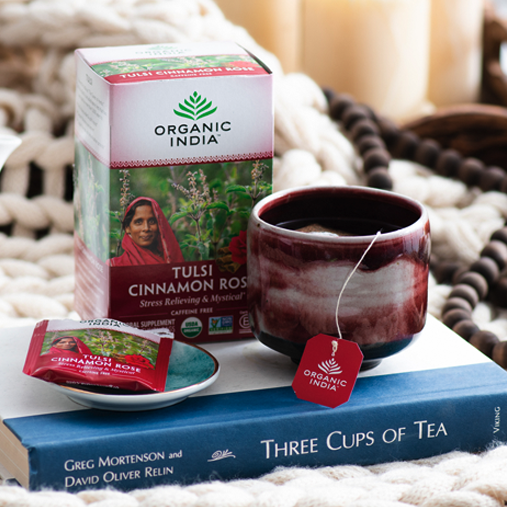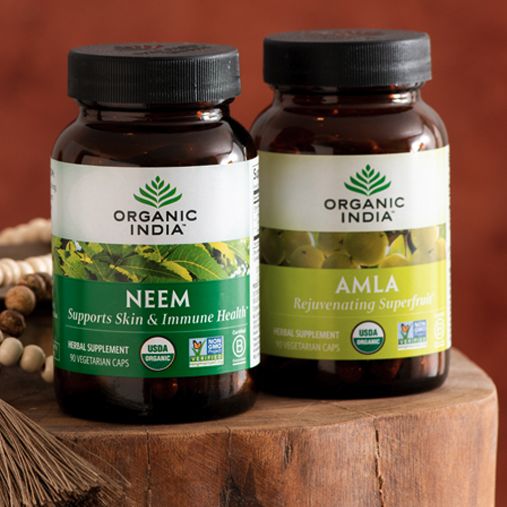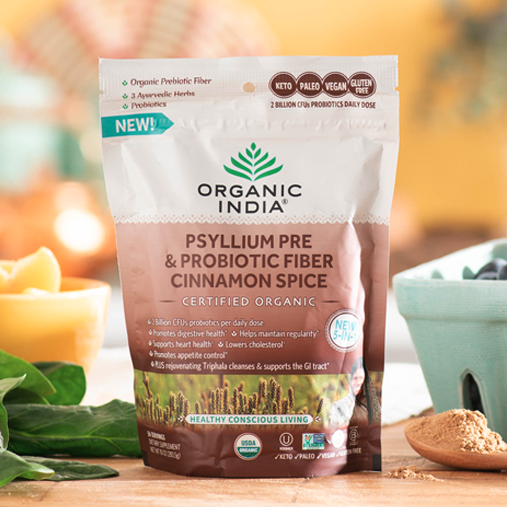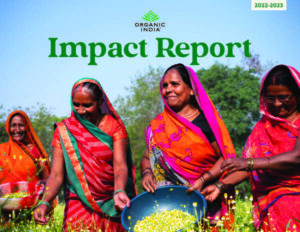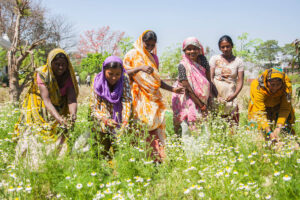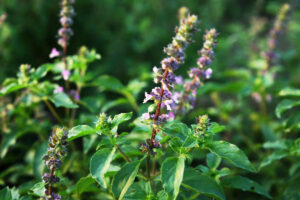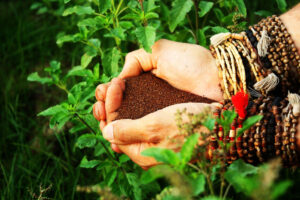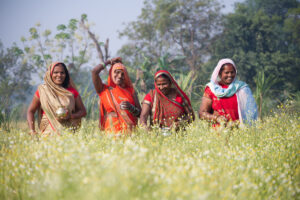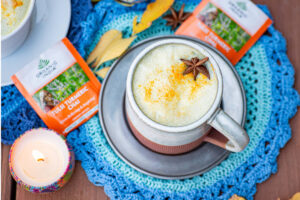Have you heard the term “Regenerative Agriculture” or “Regeneratively Grown” and wondered what it is and how it differs from Organic, naturally grown, or GMO-free agriculture?
In a world of greenwashing, corporate takeovers, and buzzwords gone mad, it’s important to understand what these labels actually mean and if or how they produce a higher-quality, safer, and more sustainable product.
This article serves as your quick reference guide to Regenerative Agriculture (a long-time Organic India passion), including:
- What Regenerative Agriculture means
- What is Regenerative Organic Certified (and why it matters)?
- The 3 Pillars of Regenerative Organic Certification
- Organic vs. Regenerative
- Why Regenerative Organic Is So Important for Human and Planetary Health
- Regenerative Organic at Organic India
You’ll also get a bird’s-eye view of what Regenerative Organic farming looks like in practice as we share Organic India’s Regenerative Organic practices and make a special announcement.
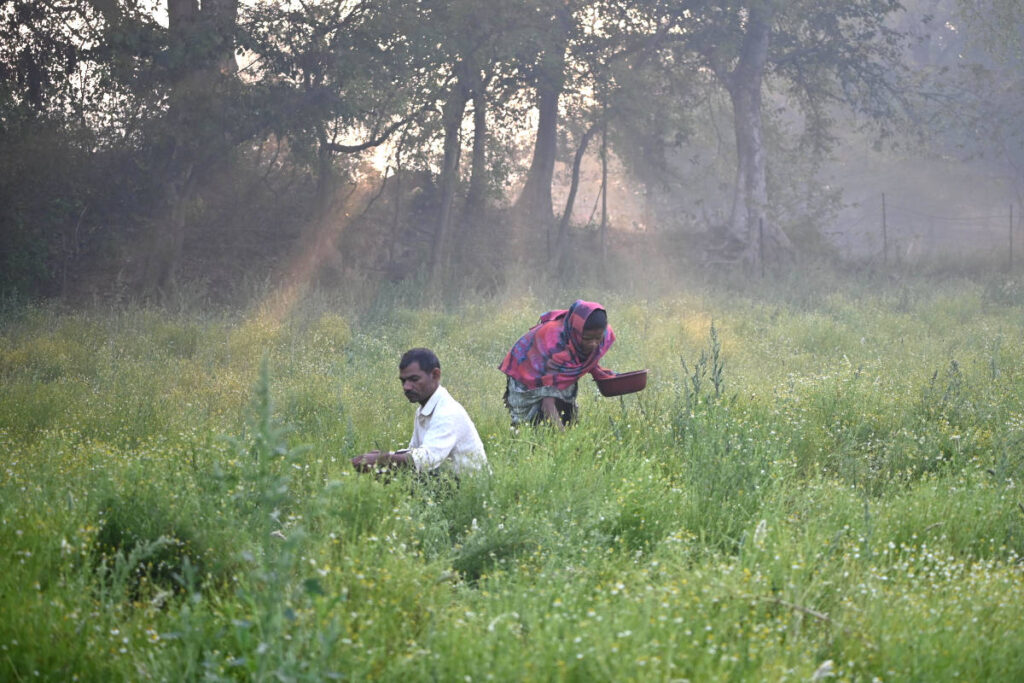
What Does Regenerative Organic Mean?
“Non-GMO,” “Organic,” “All-Natural,” “Regeneratively Grown,” “Excipient-Free,” “Made Safe”; there are many terms to keep track of on food, supplements, and natural product labels these days.
Today, we’re focusing on the labels “Regenerative Organic” and “Regenerative Organic Certified”.
“Regenerative Organic” is a term coined by Robert Rodale, J.I. Rodale’s son (Rodale Institute), to distinguish a type of farming that goes beyond sustainable or Organic.
Regenerative Organic agriculture is different from mainstream Organic or Organic sustainable agriculture in that it focuses on improving soil and natural resources versus just sustaining them.
This label can be used by any grower, rancher, supplement or personal care company, etc., who is producing food products grown using any regenerative agriculture principles, such as cover cropping, incorporation of animals, no-till or low-practices, and others we’ll cover in future sections, along with Organic certification.
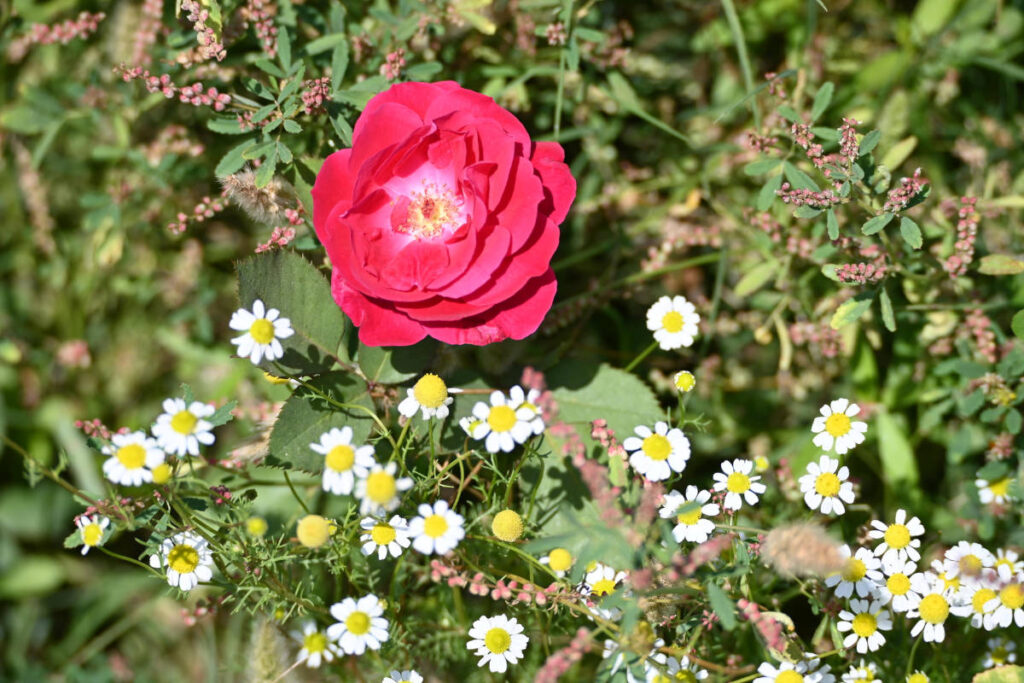
What Is Regenerative Organic Certified®?
Regenerative Organic Certified® refers to a third-party certification process for farms and food, supplements, textiles, and personal care products that meet or exceed the standards set forth by the Regenerative Organic Alliance (ROA).
ROA was founded by the Rodale Institute, Dr. Bronner’s, and Patagonia.
Their certification team consists of experts in farming, ranching, soil health, animal welfare, and farmer and worker fairness.
Per the ROA:
“Regenerative Organic Certified® is a revolutionary new certification for food, fiber, and personal care ingredients that represents the highest standard for Organic agriculture in the world, with stringent requirements for soil health, animal welfare, and social fairness.
Regenerative Organic Certified® uses the USDA Certified Organic standard as a baseline. From there, it adds important criteria and benchmarks that incorporate the three major pillars of regenerative Organic agriculture into one certification.”
ROA does not replace the USDA in certifying crops as “Certified Organic”; that is a separate certification given by the USDA that must be in place before a farm, producer, company is Regenerative Organic Certified®.
The difference between the labels: “Regenerative Organic” or “Regeneratively Grown/Raised” and “Regenerative Organic Certified®” is the third-party certification.
This doesn’t mean those who aren’t third-party certified aren’t practicing regenerative methods.
For example, you’ve likely encountered local growers who grow Organically but don’t want to pay for Organic certification. They often use the term “naturally grown” or “certified naturally grown.”
The same holds true for “Regenerative Organic” vs. “Regenerative Organic Certified®.” Some farmers and ranchers may not want to undergo the certification process even though they are employing regenerative agriculture principles.
The certification badge gives consumers peace of mind that they are getting the most healthy, eco-friendly, and climate-conscious product available.
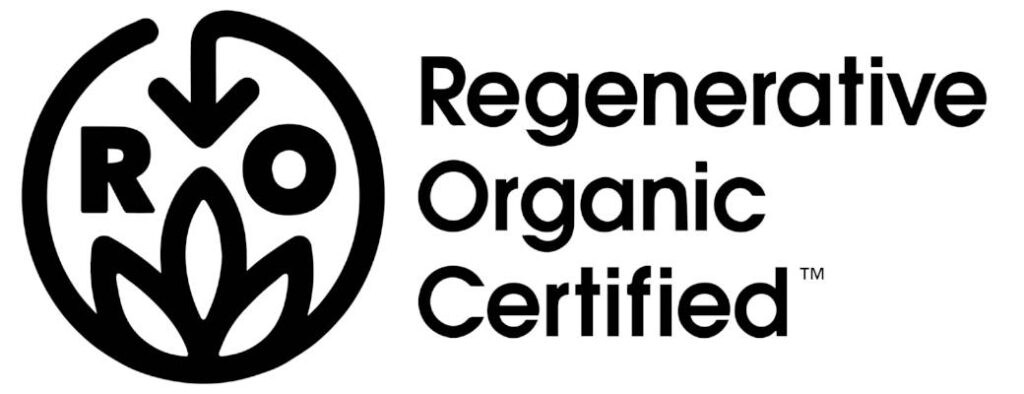
What Are The 3 Pillars Of Regenerative Organic Agriculture Certification?
There are three pillars of Regenerative Organic Agriculture® Certification with required criteria for each:
- Soil Health & Land Management: This protects the integrity of soil health (which is essential given we have about 60 years left of topsoil left!), which helps sequester carbon and protect the environment, wildlife, and aquatic life.
- Animal Welfare: This ensures animals raised for meat, milk, or fiber are treated with the utmost humane care.
- Social Fairness: This relates to the freedom and treatment of farmers and farm workers and includes equal opportunity, fair payments, freedom of democracy, living wage, and protections in place against trafficking or unfair, inhumane, or illegal employment practices.
There are also three levels of Regenerative Organic Certified®, Bronze, Silver, and Gold, based on how much producing land and revenue is in regenerative production.
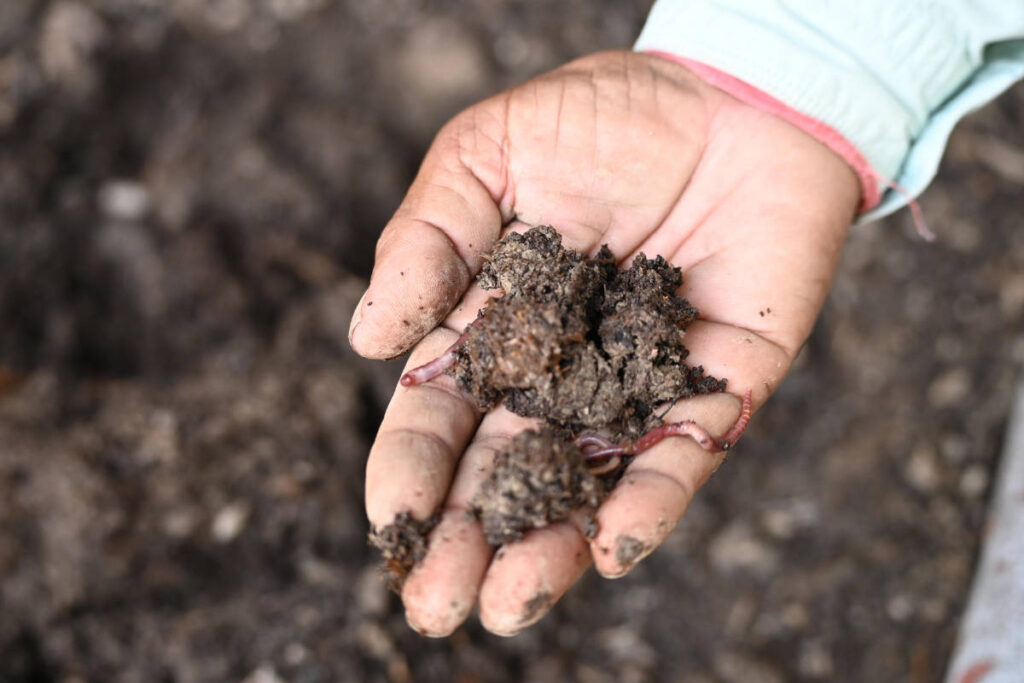
Organic vs. Regenerative
We’ve touched on this briefly, but here’s a more detailed explainer.
The USDA oversees Organic Certification of farms, ranches, and agricultural products.
The “Organic” or “Certified Organic” label indicates the food or agricultural product has been produced according to the USDA Organic standards, which require operations to use practices that cycle resources, conserve biodiversity, do not use genetically modified seeds, do not use synthetic pesticides, herbicides, fungicides, fertilizers, or insecticides, and preserve ecological balance.
A product must be certified in order to use the Organic label.
The Regenerative Organic Certified® label means a farm has been inspected by the USDA and granted “Certified Organic” status and has been certified by the ROC.
As previously mentioned, the ROC does not grant Organic certification. Therefore, a farm seeking Regenerative Organic Certification must have already undergone inspection and certification by the USDA.
Think of Regenerative Organic Certified® as Organic food or products taken up a few hundred notches in terms of soil health, environmental stewardship, and social fairness.
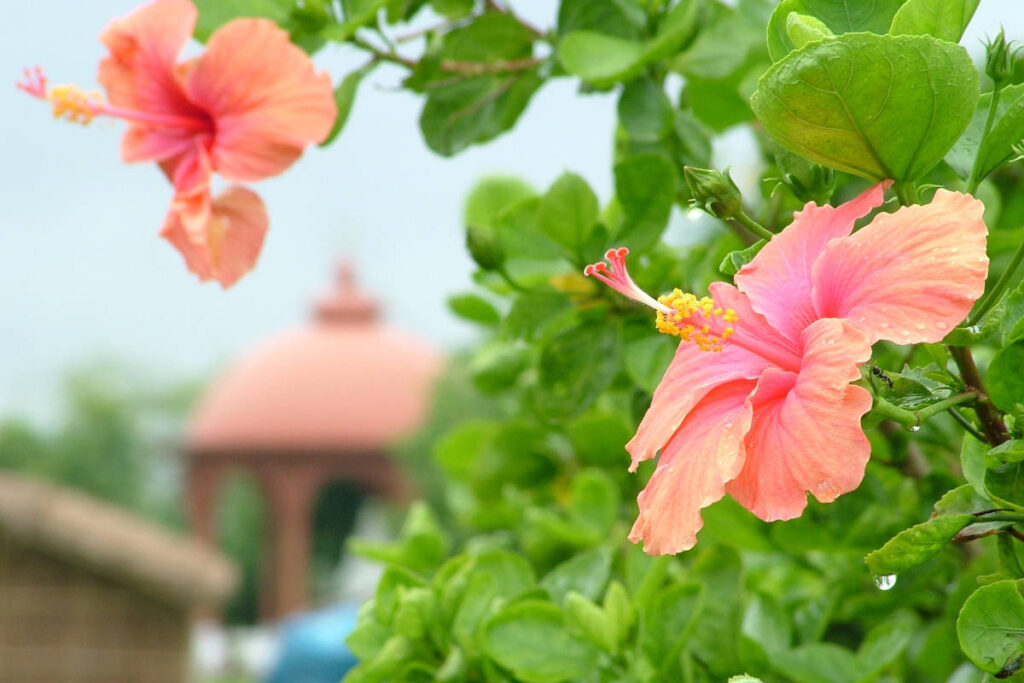
Why Is Regenerative Organic So Important?
Health- and environmentally-conscious people tend to choose Organic products because they know it’s a healthier, low-tox, and environmentally sustainable choice.
Regenerative Organic takes that a step further.
In addition to keeping harmful pesticides, herbicides, fungicides, insecticides, and other petroleum products out of the environment and waterways, Regenerative Organic Certified® farms also help by:
- Protecting land from deforestation
- Reducing chemical runoff, not just from pesticides and fertilizers, but also from textiles processed using conventionally farmed fibers
- Stopping exploitation and trafficking of workers
- Promoting fair wages and working conditions for farmers and workers
- Protecting the sovereignty and welfare of farmers and their families
- Stopping degradation of topsoil
- Reducing insect die-off, also known as “Insectageddon”
- Supporting healthy ecosystems
- Supporting wildlife
- Protecting bee and pollinator species
- Reducing carbon release from soil via low- or no-till methods
- Promoting sequestration of carbon via the soil, plants, cover crops and low- or no-till methods
- Protecting waterways
- And much more!
Organic growing and certification was an amazing “official start” to healthier more sustainable growing practices.
Today’s climate (environmental, political, and health) and other circumstances necessitate the expansion of this movement by advancing from merely sustainable agricultural practices to regenerative Organic practices.
We see regenerative Organic farming as part of our collective advancement and healing globally.
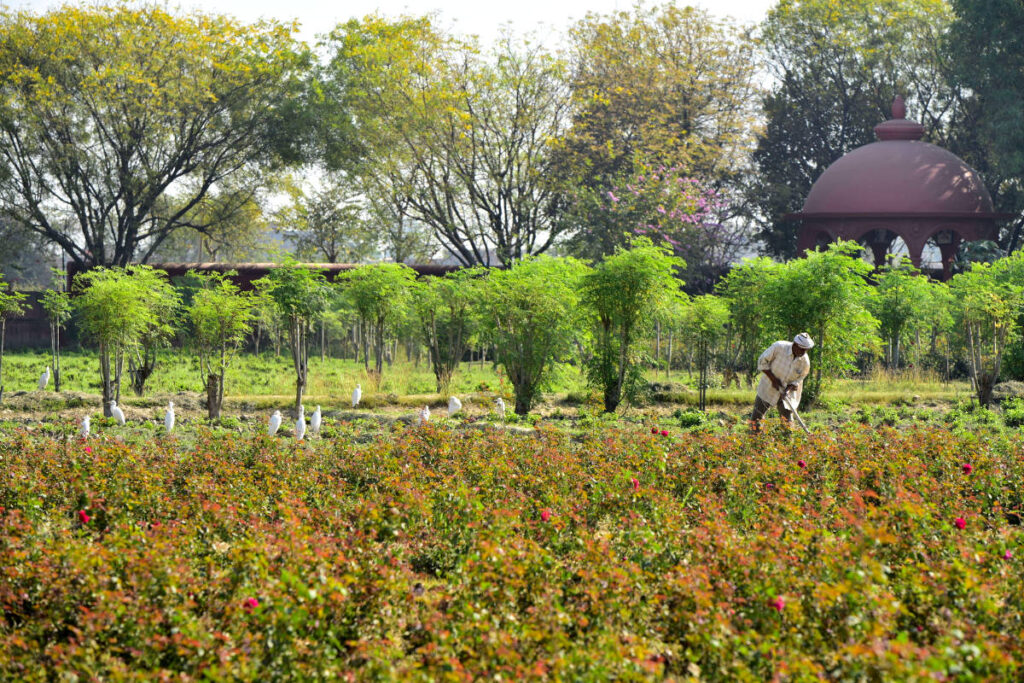
Organic India Regenerative Organic Practices
At Organic India, we have been early adopters of Organic and Regenerative Organic growing practices since our inception.
This is at the heart of everything we do here, and it has helped us create incredibly high-quality Organic Ayurvedic herbs while empowering our farmers to heal and regenerate their lands and communities and earning a fair and honest income doing what they love.
Here’s a look at what Organic India’s Regenerative Organic Practices Entail.
Dryland Farming
Also known as rain-fed agriculture, dryland farming is a waterwise practice that relies solely on natural precipitation to meet the water needs of crops during Kharif (rainy) season.
Our farmer partners utilize micro irrigation, bunding, tube wells, and pipes to irrigate crops in Rabi (dry) season.
Nearly 70% of our crops are grown in the rainy season and require no irrigation.
In a world fraught with drought and water wars (and rumors of water wars), this type of practice is essential for farmers and the planet.
Composting
Our farmer partners compost on their own farms using waste from the land and other amendments, including:
- Cow dung,
- Vermicomposting (worm composting),
- Weeds and fodder,
- And natural liquid fertilizers like Jeevamrit and Beejamrit,
This highly localized, self-sustaining ecosystem produces a rich compost that supports diverse microbial load (aka: the soil microbiome) and nutrient cycling, while building soil health and fertility naturally.
Animal Grazing
In India, owning a cow contributes to household self-sufficiency and resilience.
Many families historically owned cows for various cultural, economic, and religious reasons. Most families own a few cows, bulls, and goats.
The animals consume Organic fodder, while animal dung is used as natural fertilizer for soil fertility, contributing to compost systems for crops and reducing dependency on external sources.
Cover Crops
After Rabi season, many farmers grow what’s known as a green manure, legume crop, or Dhaincha (sesbania aculeata).
Cover crops are a cornerstone of regenerative farming and provide ground cover to prevent soil erosion, replace nutrients in the soil, and promote soil water retention by helping to build soil structure.
Green manure crops are fast-growing plants that are sown specifically for soil improvement rather than for harvesting.
We then terminate the crop and mix it into the soil before planting the next crop.
According to regenerative agriculture principles, soil should never be left bare or uncovered as this leaves it exposed to the elements, which evaporate water and nutrients while wearing away precious topsoil.
Tree, shrubs, and climber roots are alive and rooted on farms all throughout the year, contributing to soil cover.
Crop Rotation
Our partner farms implement a strategic crop rotation—a series of different crops in succession, rotating between legumes, medicinal plants, green manure/cover crops, and different crop types for family food.
This method ensures a balanced ebb and flow between plants that take certain nutrients from the soil and those that restore nutrients to the soil.
Farmers who own larger tracts of land, such as those in Rajasthan, typically employ extensive crop rotations, whereas farmers with smaller land holdings tend to have more limited rotations.
However, cultivating medicinal crops instead of traditional ones and integrating food crops within family plots contribute to sustaining this farming system
Minimal Soil Disturbance
All our herbs are handpicked, and farms are manually weeded.
Farmers practice low tillage to prepare the seed beds for sowing. There is no deep plowing, tilling or use of heavy machinery practiced on the farms.
According to regenerative agriculture principles, deep or frequent seasonal tillage is detrimental to soil health as it disturbs the microbial balance while releasing large amounts of stored carbon into the atmosphere. Therefore, no- or low-till methods are recommended.
Perennials like Gotu Kola, Moringa, and Rose are a beneficial part of the regenerative ecosystem because they remain in the field for years, establish root systems, and soil organisms form beneficial, symbiotic relationships.
Perennial crops do not require replanting and sowing, creating a no-till system that does not disturb the soil.
Agroforestry
We mentioned how regenerative agriculture helps stop deforestation, here’s an example of how.
On our partner farms, farmers utilize naturally grown trees, shrubs, and climbers on their boundaries.
Native trees are integrated on and around the farm to support synergistic relationships.
Tree fodder is used for animals, and leaves fall to the ground, building healthy soil. Shrubs and trees integrated on barriers of farms and plots also serve as protective barriers from wind and wild animals.
Unlike conventional or even Organic agriculture, regenerative agriculture encourages the inclusion of forests in farming as much as possible.
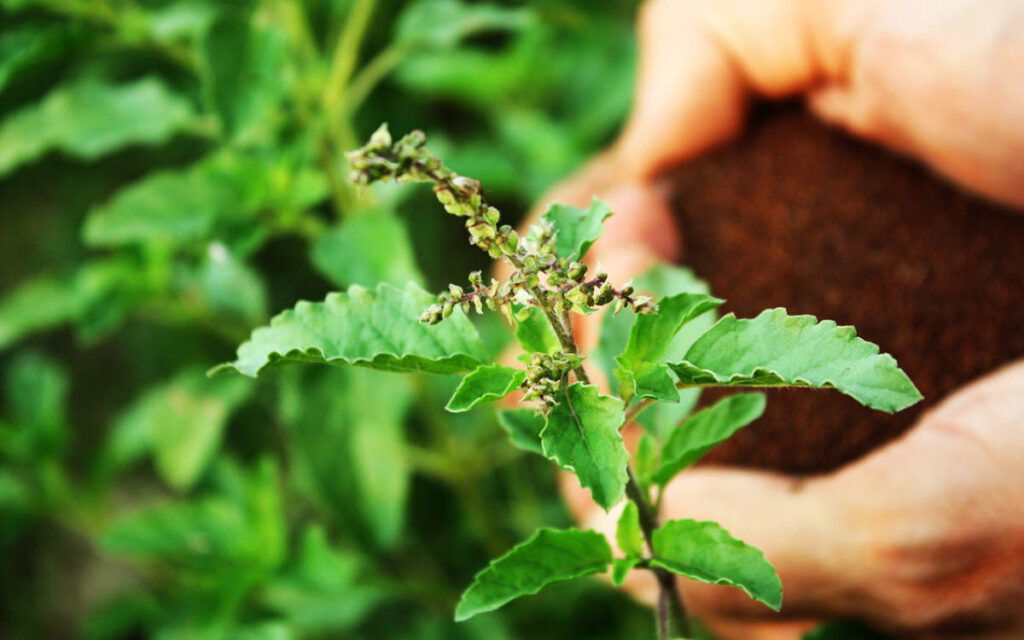
Announcing Organic India’s Newly Regenerative Organic Certified Farm
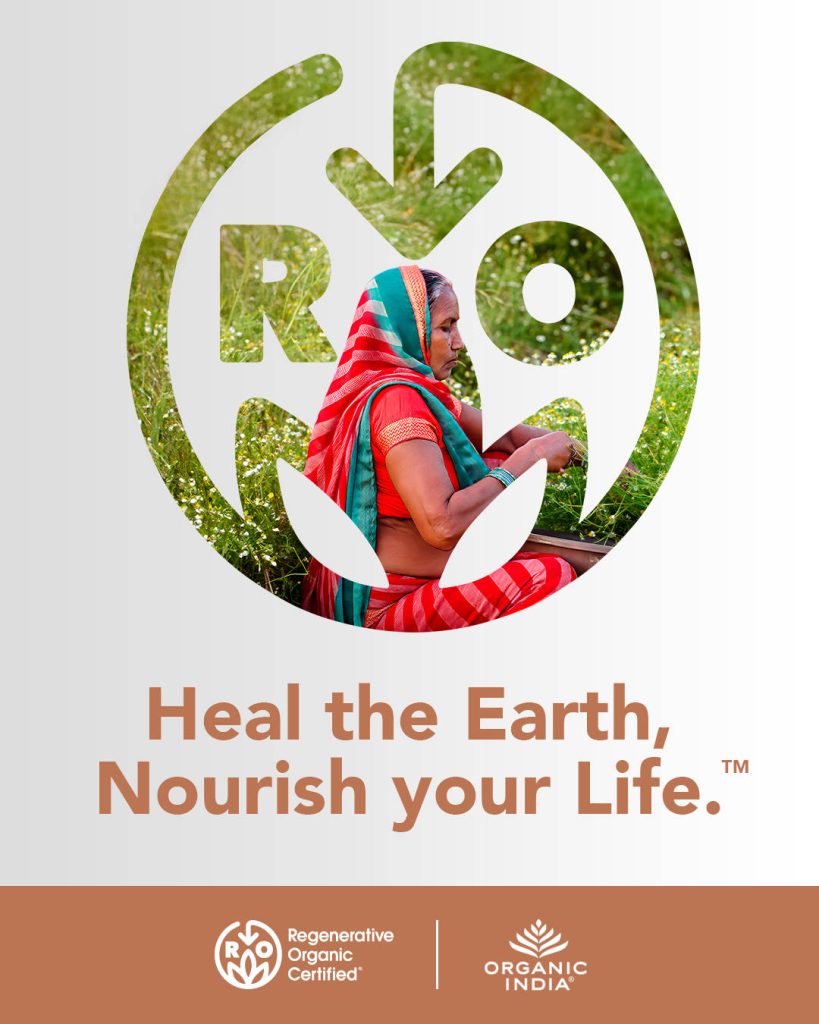
We are delighted to announce that Organic India’s inaugural farming project in Azamgarh, featuring our flagship herb Tulsi (Holy Basil), has been awarded the Regenerative Organic Certification (ROC) by the Regenerative Organic Alliance.
- Organic India Farmers Producer Company Limited was initiated in 1997 (with a three-year transition to Organic).
- The farming co-op (now over 3000 farms strong!) was established in 1999.
- Organic Certification was obtained in 2000, Fairtrade certification in 2013, and the ROC audit was performed in 2023.
We have always practiced regenerative Organic, and are now pleased to be officially third-party approved.
Through this certification, we are verified for practices that go beyond Organic and Fairtrade, verifying efforts for smallholder fairness and practices contributing to soil health. We employ protocols like our tillage action plan and soil testing (in-field and lab).
Herbs sourced here include Chamomile (Matricaria chamomilla), Tulsi, Bacopa, Hibiscus, Lemongrass, and more.
We felt it also worthy of mention that this project is specifically women powered. Very small land holdings in Azamgarh mean many women run the farms, while husbands go into town to work.
Try our NEW! ROC™ Products:
- Purely Chamomile Tea. The perfect herbal tea for your evening ritual, lovingly crafted with nothing but Single Origin Chamomile blossoms.
- Bacopa Herbal Capsules. An ancient nootropic herb for the modern intellect, crafted with high quality Bacopa grown in its native habitat.
- Neem Herbal Capsules. A single herb with mighty detox properties for everything from immunity to beauty, crafted with handpicked Neem.

Resources To Learn More
If this article has you fired up to learn more about Regenerative Organic farming, products, and gardening, we suggest the following resources:
- A Guide To Regenerative Gardening At Home
- Regenerative Organic Alliance
- Kiss the Ground, narrated by Woody Harrelson, available on Netflix
- Regenerative Agriculture On Your Dinner Plate
- How Regenerative Farming Can Make Us Happy
- Common Ground, a new documentary from the directors of Kiss the Ground

